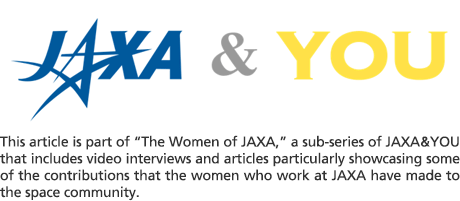
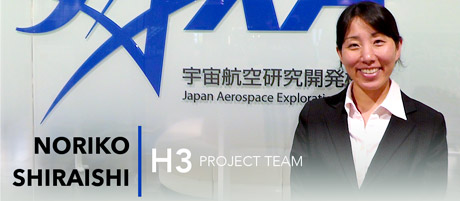
Profile
Noriko Shiraishi received her bachelor’s degree from the Department of Aerospace Engineering at Tokyo Metropolitan University in 2000 and then subsequently received her master’s in systems engineering from the same university in 2002. Soon after graduating, she joined the National Space Development Agency of Japan (NASDA; now JAXA) as a member of the launch control division of Tanegashima Space Center.
Since then, she has been integral to the development of JAXA’s launch vehicles, having served on the project teams for the H-IIA, H-IIB, and now H3. She has been the launch conductor for multiple H-IIB launches, meaning that in addition to pushing the actual launch button, she oversaw the entire launch process to ensure that it ran without issue. Along the way, Ms. Shiraishi received her doctorate in aerospace engineering from Tokyo Metropolitan University in 2013. In this interview, she discusses her interest in rockets, her time at JAXA, and the new H3 Launch Vehicle.
Interview
What’s your current job?
I am currently developing a new rocket called the H3 Launch Vehicle as part of the H3 Project Team.
So you used to be involved with the H-IIB Launch Vehicle as a launch conductor, but how exactly are you involved in the H3 Project?
We aim to launch the H3 in FY2020 as a completely new rocket, but it is developed from technology that was first inspired by the development of the H-IIA and H-IIB Launch Vehicles. As for its use, we aim for the H3 itself to be efficient and cost-effective. The concept behind H3 is that, if we make both domestic and international space missions consistently successful, we believe that we will provide a way for Japan to stably access space for the twenty years once the rocket succeeds. So the job that I do now is not exactly involved in the development of the rocket's technology itself so much as it is involved in creating the policies that support the successful use and operation of the H3.
So you're evidently interested in rockets. What originally got you interested in them?
Yes, well originally I was specifically interested in airplanes. I kept on thinking that I wanted to fly, and that lead to my interest in aviation, so I ended up studying aerospace engineering in college. During undergrad, I became familiar with rockets, and then while I was in graduate school, the H-IIA was under development because the H-II continued to fail. But hearing about how getting the rocket to fly was still very difficult, I thought, wow, that looks like a job that was worth doing, and so I decided to pursue a career related to rockets.
Out of your time working at JAXA, what has left the largest impression on you and why?
You mentioned this before a little bit, that I was involved in the launch of the H-IIB rocket. And as the launch conductor, I was the one who actually pushed the launch button. It's quite nerve-wracking, but to be able to launch with your own hands the rocket that everyone has been devoted to is an amazing experience.
So do you have any hobbies or interests that surprises others?
Yes, well, are you familiar with hang gliders? Because I was originally interested in planes, I was interested in flying. I first started in my college years, and now I have a license, so I can fly all by myself. So you could say my hobby is flying.
Finally, please give us a message to young girls who are interested in aerospace.
Because it challenges you to create new things, there are many difficult parts of being involved in aerospace. But because of that, it truly is a job in which you do something worthwhile. And of course, for girls there are many options, and out of all of those you might be worried about which path to follow. In my case, I focused on my interest in the skies, and from that came rockets and those sorts of things. Because they continue to provide me with valuable experiences, certainly for everyone else, focus on what you're interested in, and I believe you will be able to pursue your dreams.
More on the Rockets
H-II
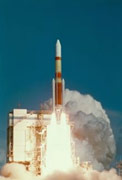 The H-II Launch Vehicle, which first underwent development in 1984 and then first launched in 1994, was Japan’s first two-stage rocket to be developed solely with domestic technology. Intended to launch satellites, its total capacity was two tons, and it successfully launched a variety of satellites into orbit from 1994-1997. It first began to fail in 1998, and a subsequent failure in 1999 resulted in NASDA (now JAXA) cancelling the program in favor of upgrading the system.
The H-II Launch Vehicle, which first underwent development in 1984 and then first launched in 1994, was Japan’s first two-stage rocket to be developed solely with domestic technology. Intended to launch satellites, its total capacity was two tons, and it successfully launched a variety of satellites into orbit from 1994-1997. It first began to fail in 1998, and a subsequent failure in 1999 resulted in NASDA (now JAXA) cancelling the program in favor of upgrading the system.
H-IIA
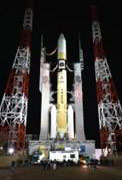 As the official upgraded version of the H-II, the H-IIA Launch Vehicle first launched in 2001, and boasts a more simplified and efficient design than its predecessor. Intended to serve a variety of needs, in its 30 launches since 2001, the H-IIA has successfully transported not only satellites into geostationary orbit, but a spacecraft into lunar orbit and a space probe to Venus. In 2007, JAXA transferred the H-IIA’s service operations to Mitsubishi Heavy Industries, but the rocket is still launched from JAXA’s Tanegashima Space Center, where JAXA oversees the H-IIA launch safety management.
As the official upgraded version of the H-II, the H-IIA Launch Vehicle first launched in 2001, and boasts a more simplified and efficient design than its predecessor. Intended to serve a variety of needs, in its 30 launches since 2001, the H-IIA has successfully transported not only satellites into geostationary orbit, but a spacecraft into lunar orbit and a space probe to Venus. In 2007, JAXA transferred the H-IIA’s service operations to Mitsubishi Heavy Industries, but the rocket is still launched from JAXA’s Tanegashima Space Center, where JAXA oversees the H-IIA launch safety management.
H-IIB
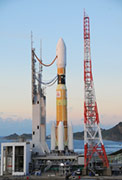 The H-IIB Launch Vehicle is a stronger, upgraded version of the H-IIA. It notably is involved in launching KOUNOTORI (HTV), JAXA’s H-II transfer vehicle, to the International Space Station to transport necessities such as food, spare parts, and experimental equipment. KOUNOTORI is also used to transport satellites to the ISS, where they are remotely deployed. The H-IIB can carry a maximum payload of four tons, double that of the H-IIA, and it has successfully launched KOUNOTORI five times since 2009. In addition to supplies for the ISS, in these launches, KOUNOTORI has carried satellites for not only Japan, but for Vietnam, the US, Brazil, Denmark, and the Philippines.
The H-IIB Launch Vehicle is a stronger, upgraded version of the H-IIA. It notably is involved in launching KOUNOTORI (HTV), JAXA’s H-II transfer vehicle, to the International Space Station to transport necessities such as food, spare parts, and experimental equipment. KOUNOTORI is also used to transport satellites to the ISS, where they are remotely deployed. The H-IIB can carry a maximum payload of four tons, double that of the H-IIA, and it has successfully launched KOUNOTORI five times since 2009. In addition to supplies for the ISS, in these launches, KOUNOTORI has carried satellites for not only Japan, but for Vietnam, the US, Brazil, Denmark, and the Philippines.
H3
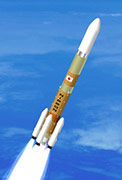 The H3 is currently under development and is tracked to be JAXA’s next flagship launch vehicle. It features three H’s: high flexibility, high reliability, and high cost performance. The H3 will not only be able to carry over 6.5 tons of payload into geostationary orbit, but it will be customizable to each customer’s respective needs. The H3’s maiden launch is scheduled for 2020.
The H3 is currently under development and is tracked to be JAXA’s next flagship launch vehicle. It features three H’s: high flexibility, high reliability, and high cost performance. The H3 will not only be able to carry over 6.5 tons of payload into geostationary orbit, but it will be customizable to each customer’s respective needs. The H3’s maiden launch is scheduled for 2020.
By Miranda Feliciano Tyson
Edited by Fumika Miyamoto
Publication date: August 29, 2016